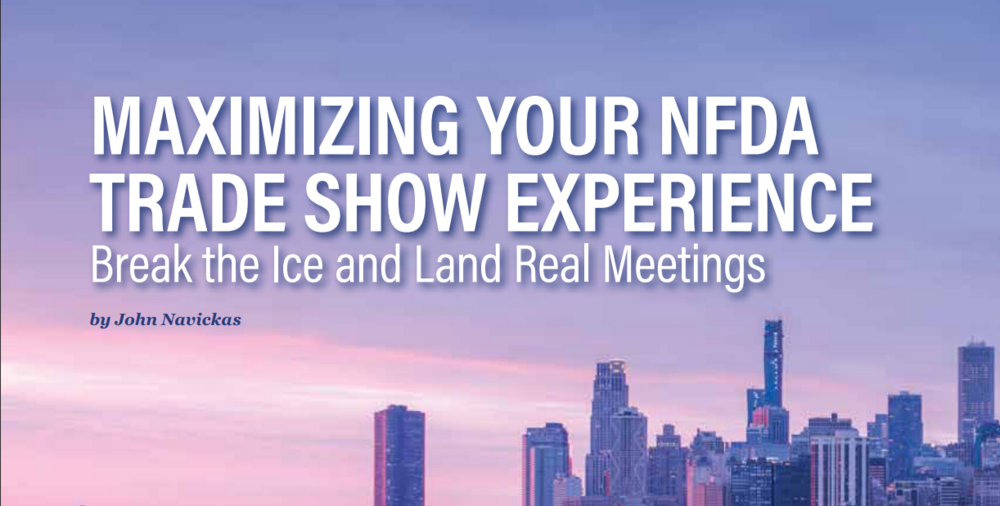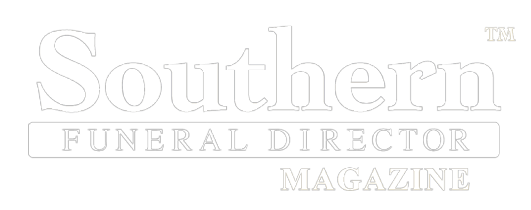(404) 312-6640
Maximizing Your NFDA Trade Show Experience
Walk any trade show floor, whether it’s your state association’s event or the upcoming NFDA International Convention & Expo in Chicago, and you’ll see two kinds of people. The first kind are wanderers, the people drifting from booth to booth, scooping up swag, and making polite small talk without much intention. The second kind are scattershot hunters, the people who fire off the same pitch to anyone with a badge, hoping something sticks.
Both of these people are wasting their time and money. Don’t be these people. The real pros approach trade shows like seasoned big game hunters. They don’t chase every rabbit that crosses their path. They know exactly what they’re after, and they prepare for it. They study the habits and patterns of their target so they can be in the right place at the right time. And when the opportunity presents itself, they act with precision. (And for the record, I’m not a hunter. Never have been. But the metaphor works, so stay with me here.) Trade shows like NFDA are no different. Success doesn’t come from volume. It comes from focus, preparation, and the ability to break the ice in a way that feels natural, genuine, and human. That means knowing who you want to meet, being ready to start a real conversation, and making sure you stand out from the hundreds of other people trying to sell something with the same tired lines.
START WITH THE RIGHT MINDSET
The easiest way to blow a first impression is to treat it like a transaction. If someone feels like you’re sizing them up for their wallet, the walls go up fast. Wouldn’t you react the same way? But swing too far in the other direction, like pretending to be overly casual or falsely warm (i.e., used car salesman), and people smell that, too. The key is to walk in with this mindset: I’m here to learn, I’m here to share, and if there’s a fit, we’ll both know it. When you approach people with curiosity instead of agen da, they feel it. When you’re upfront about why you wanted to connect, without pushing too hard, it disarms them. They see you as someone who respects their time and has something worthwhile to say. That’s the sweet spot.
PREPARATION MAKES THE CONVERSATION
The most natural conversations happen when you’ve done your homework. Before you get on the plane, know who you want to meet. Review the attendee list. Follow hashtags tied to the show. Look at LinkedIn updates. Research prospects on LinkedIn and online. This prep work isn’t about creating the perfect script; it’s about giving yourself material for an opener that isn’t generic. Instead of “So, what do you do?”, you can say, “I caught your panel on the increase in cremations vs burials. You had a point that really stood out to me…” And it goes further than that. If you’ve researched your target accounts before the show, you walk in already knowing what’s new in their world. A recent product launch. A change in leadership. A market challenge they’ve been talking about online. When you bring that into the conversation, you separate yourself from the 1,001 others who are trying to sell them blindly with canned speeches. They’ve already heard those lines at the booth next door. What they haven’t heard is someone who bothered to understand their business first. That’s how you cut through. Another vastly underused tactic is reaching out before the show begins. LinkedIn is your friend here. A simple message saying, “I’ll be at NFDA in Chicago. Would you have 10 min utes to meet for coffee or a quick chat?” can open doors that cold booth drop-ins never will. These meetings don’t need to be formal. Sometimes the best ones happen over lunch, a drink after sessions, or even standing in a hallway between keynotes. When you line up a few of these in advance, you walk into the show with momentum, not just hope. Preparation also helps you avoid wasting time. You don’t need to chase down every badge on the floor. You need to fo cus on the ones that matter to your goals. That could be sales, partnerships, or just getting smarter about your industry. Personally, an even mix of all of these ensures short term and long-term growth.
BREAKING THE ICE WITHOUT FREEZING THE ROOM
The first thirty seconds set the tone. You don’t need a flashy line. You need something simple, authentic, and rele vant to the setting. Here are a few reliable approaches: • Reference the context. “This booth has been busy all morning. How are you holding up?” • Connect to content. “I saw your company just launched [product/service]. How’s the feedback been so far?” • Be human. “These convention centers are a maze. Have you figured out how to find the coffee line yet?” Notice that none of these are about you. They’re about the other person, or about the shared environment. That’s what gets people talking. And once they’re talking, you can start moving the conversation toward why you wanted to connect in the first place.
BE UPFRONT, BUT DON’T BE ABRUPT
At some point, you need to transition from small talk to business. The trick is not to hide it or delay it too long. If you came to this person because you think there’s potential to work together, say so. But how you say it matters. Bad version: “I’d like to sell you our software. Do you have time for a demo?” Better version: “I was hoping to connect because I think there may be a way our teams could work together. No pitch right now, I just wanted to introduce myself and hear a little about what you’re focused on this year.” What version would you rather have said to you at the show? The second version is upfront without being abrupt. It makes your intentions clear but leaves the door open for a two-way conversation. It also tells them you respect their boundaries. And here’s the real key: it has to be about solutions, not products. The person you’re talking to may be the decision maker, or they may be the gatekeeper who can open the door to one. Either way, if you can show them a hook for how you make their daily life easier, like less hassle, more efficiency, fewer headaches… you’ll stand out. Nobody wakes up in the morning wanting to be sold a product. But everybody wakes up hoping their job will be a little smoother. If you can connect your solution to that feeling, you’ll make a lasting impression.
KEEP THE CONVERSATION BALANCED
One of the easiest mistakes at a trade show is talking too much. Nerves kick in, and before you know it, you’re unload ing your entire sales deck in the middle of the aisle. Don’t be that person. A good rule of thumb is 70/30: they should talk 70% of the time, you 30%. In fact, the goal is to keep them talking about themselves. Their business. Their challenges. Their goals. Because here’s the thing: most people at trade shows are used to not getting a word in edgewise. Salespeople throw pitch after pitch, barely taking a breath, and it all blurs together. Flip the script. Let them talk and actually listen. I can’t emphasize enough about the art of listening here. You’ll get more valuable information in five minutes of them describing their world than in twenty minutes of you rattling off features. And the best part? It gives you genuine fuel to keep the conversation flowing in a way that feels natural, not forced.
THE ART OF A QUICK MEETING
If the initial conversation clicks, suggest a short sit-down during the show. Not an hour. Not even thirty minutes. Fifteen minutes is plenty. Frame it like this: “I don’t want to take up your floor time; you didn’t fly out here to see me. But would you have 15 minutes tomorrow morning to talk about this in more detail over coffee? I think there’s some alignment here, and I’d love to hear your thoughts without rushing.” The limited time frame makes it low-pressure. And if they agree, you’ve moved from a casual chat to a real meeting, the entire point of showing up at the show.
HANDLING THE BRUSH-OFF
Not every interaction will lead somewhere…and that’s okay. Some people will cut you short. Some will say they’re not interested. Don’t take it personally. Just smile and move on. Remember, nothing screams “desperate” like chasing someone down the aisle after they’ve already said no. Don’t be that person either. The best response is gracious: “I totally understand. Thanks for the minute, I’ll let you get back to it. Have a great show.” Why? Because trade shows are small worlds. You’ll see these people again. And the way you handle rejection says more about your professionalism than the way you handle success.
FOLLOW-UP IS WHERE THE REAL WORK HAPPENS
A great conversation at the show means nothing if you vanish afterward. The key is to follow up quickly, personally, and specifically. Within 48 hours, send a short note: remind them who you are, where you met, and what you talked about. If you promised to send something, a link, a resource, an introduction, then do it. And keep the tone just as genuine as it was at the show. Talk with them, not at them. Avoid the generic “Great to meet you at [Event]. Let’s schedule a call.” Instead, say: “I enjoyed our chat about [topic]. You mentioned [pain point], and I’d love to share a case study that might be relevant. Would you be open to a quick call next week?” That small detail proves you listened, and it separates you from the dozens of other follow-ups sitting in their inbox.
THE BALANCE THAT WINS
At the end of the day, trade shows aren’t about acting to be someone you’re not. They’re about being yourself, but prepared. Being honest, but respectful. Being human, but intentional. Authentic. And that’s where the hunter allegory wraps things up. The successful hunter doesn’t spray arrows in every direction. He doesn’t waste time chasing small game when he’s after something rare. He’s patient, observant, and ready when the right moment comes. Approach NFDA or any trade show the same way. Do your research. Learn the patterns. Be in the right place at the right time. Then break the ice with clarity and confidence, without being pushy or fake. If you do that, you’ll separate yourself from the noise, land the meetings you came for, and be remembered as the one person who came prepared with both a plan and a personality. Be this person.
John Navickas is the Founder and President of Funeral Home Success (FHS), a full-service growth agency serving the funeral industry. With nearly 15 years in the death care space, he’s helped hundreds of clients grow through smarter marketing and creative engagement. Before FHS, John held senior roles at top marketing and advertising agencies, where he led global brand launches, campaign strategy, and the integration of emerging technologies for clients across multiple industries. You can reach him at john@FuneralHomeSuccess.com






Comments